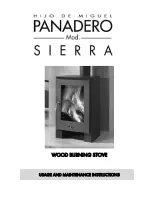
The stove must not be installed within the specified minimum distances to combustible materials: A gap of at least 200mm
needs to left between the stove and any combustible materials at the sides and 200mm to the rear. Adjacent walls should be of
non-combustible materials and construction, preferably masonry or brickwork.
All combustible items must be kept well clear of the stove, including log store, furniture, curtains etc and any item movable
or otherwise which may pose a fire hazard.
Your stove will require a constant air supply, and should not be used at the same time and in the same room/space as
extractor fans or any device which may draw air supply away from the stove.
The stove should be installed on a level floor with adequate load bearing capacity.
The stove needs to stand on a hearth of non-combustible materials not less than 12mm thick conforming to Building
Regulations.
At least one permanent external air vent should be installed in the same room as the stove, to ensure a constant air supply for
combustion. It should consist of a total free area of at least 10500mm². – ie a square opening of 100mm x 100mm would be
the minimum requirement. The vent should be positioned such that it is not liable to blockage.
NOT suitable for installation in a shared flue system.
If installed in a standard type chimney, a register plate needs to be fitted inside the chimney.
When purchasing flue pipe, 6” diameter is required. The flue pipe must be fitted INSIDE the flue spigot, and sealed with a
generous amount of Fire Cement.
Access should be provided for cleaning the flue gas connector and chimney flue to ensure that the passageways for exhaust
gases remain free from obstruction.
Flue Draught
Flue draught should be measured at full output when up to full operating temperature and must be within the following limits:
12 to 18 Pascals. – If the flue draught at full output exceeds the upper limit, then a suitable flue draught stabiliser must be
fitted to avoid overfiring and to allow sufficient burn-rate control.
We recommend that you have a qualified fitter install your stove. The British recognised standard for solid fuel installations
is HETAS. You can find a HETAS qualified installer in your area by going to the HETAS website –
www.hetas.co.uk
.
Plumbing
IMPORTANT: - your stove MUST be plumbed in before use. Under no circumstances should it be ‘run dry’ – this
would likely cause significant damage which would not be covered under warranty.
Please note: Saltfire Stoves do not design heating systems. A suitably qualified installer should produce a safe system
design with detailed plans following a site survey. The design should be in conjunction with relevant local and national
Building Regulations.
The information provided below is intended to help as a minimum requirements guide only.
Open Vented Only
Your stove is suitable only for use in open vented systems – this means that it must be installed such that there can be no risk
of the boiler jacket pressurising with increased water temperature. It must never be installed into sealed/ pressurised systems.
However, using safe methods of system ‘link-ups’ your stove can be used when installed safely, in conjunction with other
heating sources which may themselves be sealed systems. An example of this would be to use a thermal store with suitable
automatic control system.
For a traditional basic ‘gravity’ system which enables indirect heating of a DHW (domestic hot water) cylinder and a pumped
radiator heating circuit, a diagram is included in this manual as an example only (Diagram Fig.3) – please note this diagram is




























